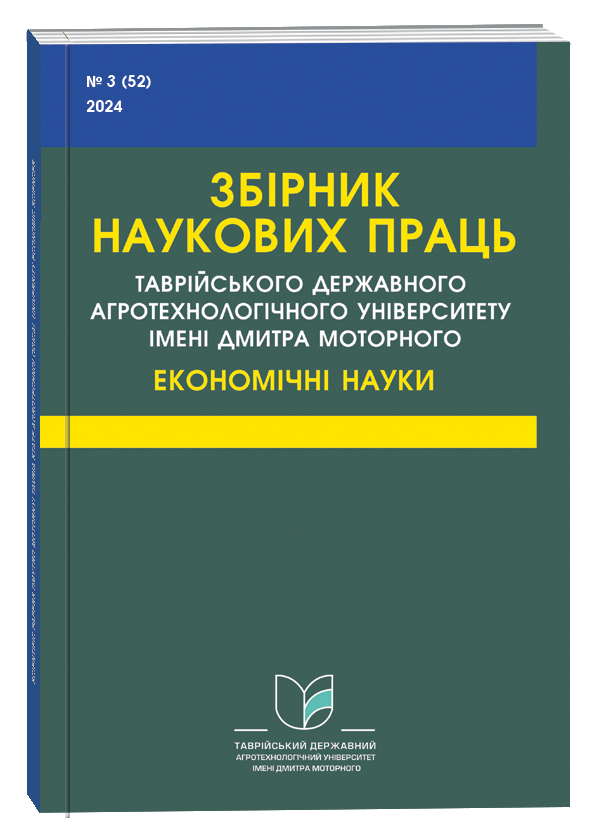МОДЕЛЮВАННЯ СИСТЕМНИХ ФАКТОРІВ ЗАБЕЗПЕЧЕННЯ ФІНАНСОВОЇ БЕЗПЕКИ СУБ’ЄКТІВ АГРОПРОДОВОЛЬЧОГО РИНКУ НА РЕГІОНАЛЬНОМУ РІВНІ
Анотація
В статті розглянуто процес моделювання системних факторів фінансової безпеки суб’єктів агропродовольчого ринку на регіональному рівні. Використано на засадах системного підходу математичний інструментарій до оцінювання фінансової безпеки суб’єктів агропродовольчого ринку в часовому просторі. Встановлено кількісні та якісні параметри загроз ендогенного та екзогенного характеру, що ідентифікують пороговий інтервал стійкого фінансового стану суб’єктів агропродовольчого ринку на регіональному рівні. Виокремлено системні фактори стимулюючого та дестимулюючого характеру для оцінки фінансової безпеки суб’єктів агропродовольчого ринку та запропоновано множину індикаторів для аналізу складових фінансової безпеки, що забезпечують процес нейтралізації реальних та потенційних загроз забезпечення стабільного рівня фінансової безпеки суб’єктів агропродовольчого ринку. Обґрунтовано доцільність здійснення нормалізації індикаторів, врахування їх порогові значення, вагові коефіцієнти та структуру капіталу при розрахунку інтегрального рівня фінансової безпеки. Доведено, що впровадження системних факторів за загальним рівнем фінансової безпеки дозволяє підвищити фінансову стійкості функціонування суб’єктів агропродовольчого ринку.
Посилання
Брігхем Є. Основи фінансового менеджменту. Київ : Молодь, 1997. 1000 с.
Боронос В.Г. Методологічні засади управління фінансовим потенціалом території: монографія. Суми : Сумський державний університет, 2011. 310 с.
Вдовенко О.С. Економічна сутність фінансової безпеки суб’єктів господарювання аграрного сектору. Економіка АПК. 2014. № 1. С. 125–129.
Геєць В. Макроекономічна оцінка грошово-кредитної та валютно-курсової політики України до і під час фінансової кризи. Економіка України. 2009. № 2. С. 5–23.
Задерей В.Ю. Методи оцінки вартості компаній. Агросвіт. 2017. № 5. С. 48–54.
Крамаренко Г.О. Фінансовий аналіз і планування. Київ : Центр навчальної літератури, 2003. 224 с.
Крисак Я.В., Ластівка І.О. Фінансова математика. Фінансові потоки. Київ: Видавництво Національного авіаційного університету «НАУ-друк», 2009. 88 с.
Лойко В.В., Лойко Д.М. Експертна система як інструмент визначення рівня економічної безпеки. Науковотехнічна інформація. 2015. № 3(65). С. 41–46.
Chesbrough H. Business Model Innovation: Opportunities and Barriers. Long Range Planning. 2010. № 43. P. 354–363.
Gaspar J., Vasconcelos P.B., Afonso O. Economic growth and multiple equilibria: A critical note. Economic Modelling. 2014. Vol. 36. P. 157–160.
Lagerkvist Carl J. Assessing farmers’ risk attitudes based on economic, social, personal, and environmental sources of risk: evidence from Sweden. American Agricultural Economics Association Annual Meeting, Providence, Rhode Island. 2005. July 24–27. URL: http://ageconsearch.umn.edu/bitstream/19361/1/sp05lа01.рdf (дата звернення 08.10.2024).
Lan Joe. Analyzing Growth Rates. American Association of Individual Investors Journal. 2013. Vol. 3. URL: http://www.aaii.com/journal/article/analyzing-growth-rates (дата звернення 08.10.2024).
McGrath R.G., Macmillan I.C. Discovery driven planning. Harvard Business Review. 1995. Vol. 73(4). P. 44–54.
Narkunienė J., Ulbinaitė A. Comparative analysis of company performance evaluation methods. Entrepreneurship and Sustainability Issues. 2018. Vol. 6(1). P. 125–138. URL. https://hal.science/hal-02121048v1/file/Narkuniene_Comparative_analysis_of_company_performance_evaluation_methods.pdf (дата звернення 08.10.2024).
Plaskova S. Improvement of methodological tools for business analysis of the effective company’s performance. Management Sciences. 2022. Vol. 12(1). P. 32–41.
Robinson L.J., Barry P.J., Klibenstein J.B. Risk attitudes: Concepts and measurement. Risk management in agriculture. Iowa State University Press. 1984. Vol. 1-2. Р. 11–30.
Trusova N. Systemic factors of projected financial potential of business entities. Economic annals – XXI. 2016. Vol. 161(9-10). P. 61–65.
Brigham E. (1997) Basics of financial management. Kyiv: Molod.
Boronos V. G. (2011) Methodological principles of managing the financial potential of the territory: monograph. Sumy: Sumy State University.
Vdovenko O. S. (2014) The economic essence of the financial security of economic entities in the agrarian sector. Economics of agro-food complex, no. 1, pp. 125–129.
Geets V. (2009) Macroeconomic assessment of the monetary and exchange rate policy of Ukraine before and during the financial crisis. Economy of Ukraine, no. 2, pp.5–23.
Zaderey V. Yu. (2017) Methods of assessing the value of companies. Agrosvit, no. 5, pp.48–54.
Kramarenko G. O. (2003) Financial analysis and planning. Kyiv: Center for Educational Literature. 224 p.
Krysak Y. V., Lastivka I. O. (2009) Financial mathematics. Financial flows. Kyiv: Publishing House of the National Aviation University "NAU-druk".
Loiko V. V., Loiko D. M. (2015) Expert system as a tool for determining the level of economic security. Scientific and Technical Information, no. 3 (65), pp.41–46.
Chesbrough H. (2010) Business Model Innovation: Opportunities and Barriers. Long Range Planning, no. 43, pp. 354–363.
Gaspar J., Vasconcelos P. B., Afonso O. (2014) Economic growth and multiple equilibria: A critical note. Economic Modelling, no. 36, pp. 157–160.
Lagerkvist Carl J. (July 24–27, 2005) Assessing farmers’ risk attitudes based on economic, social, personal, and environmental sources of risk: evidence from Sweden. American Agricultural Economics Association Annual Meeting, Providence, Rhode Island. Available at: http://ageconsearch.umn.edu/bitstream/19361/1/sp05lа01.рdf
Lan, Joe. (2013) Analyzing Growth Rates. American Association of Individual Investors Journal, no. 3. Available at: http://www.aaii.com/journal/article/analyzing-growth-rates
McGrath R. G., Macmillan I. C. (1995) Discovery driven planning. Harvard Business Review, no. 73(4), pp.44–54.
Narkunienė J., Ulbinaitė A. (2018) Comparative analysis of company performance evaluation methods. Entrepreneurship and Sustainability Issues, no. 6(1), pp. 125–138. Available at: https://hal.science/hal-02121048v1/file/Narkuniene_Comparative_analysis_of_company_performance_evaluation_methods.pdf
Plaskova S. (2022) Improvement of methodological tools for business analysis of the effective company’s performance. Management Sciences, no. 12(1), pp. 32–41.
Robinson L. J., Barry P. J., Klibenstein J. B. (1984) Risk attitudes: Concepts and measurement. Risk management in agriculture. Iowa State University Press, no. 1-2, pp.11–30.
Trusova N. (2016) Systemic factors of projected financial potential of business entities. Economic annals – XXI, no. 161(9-10), pp. 61–65.

